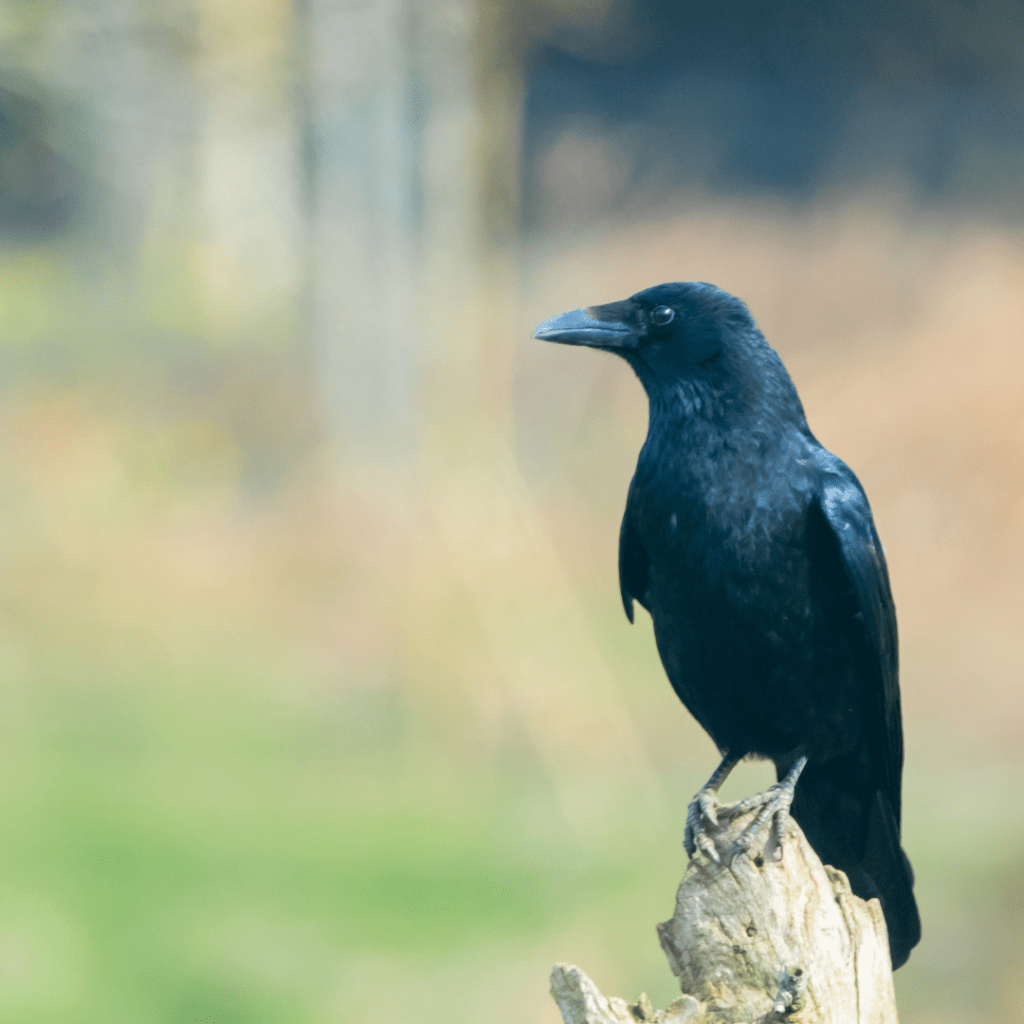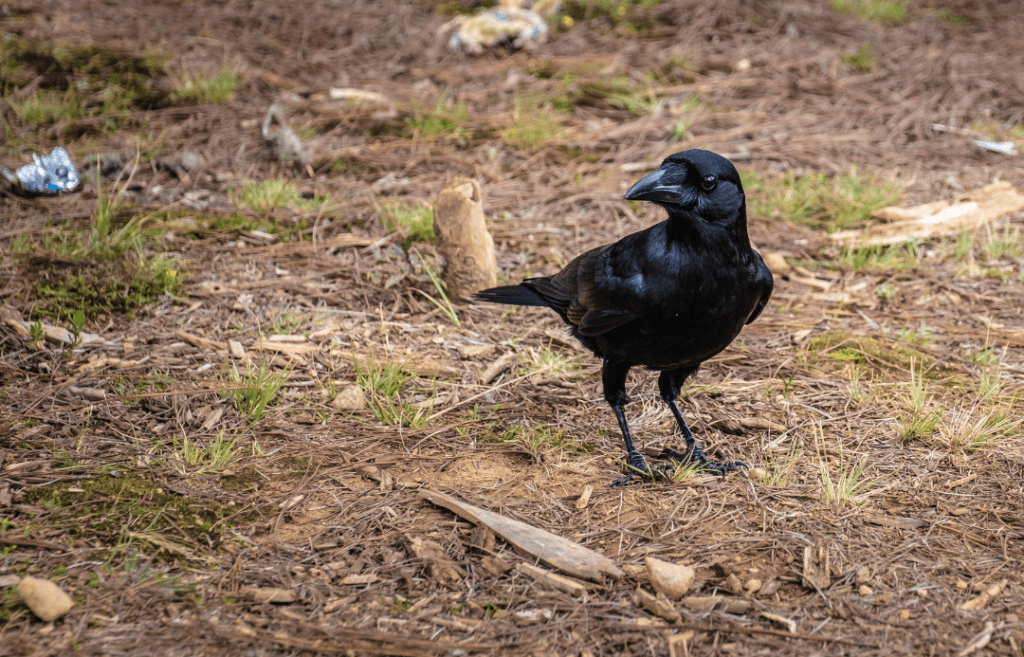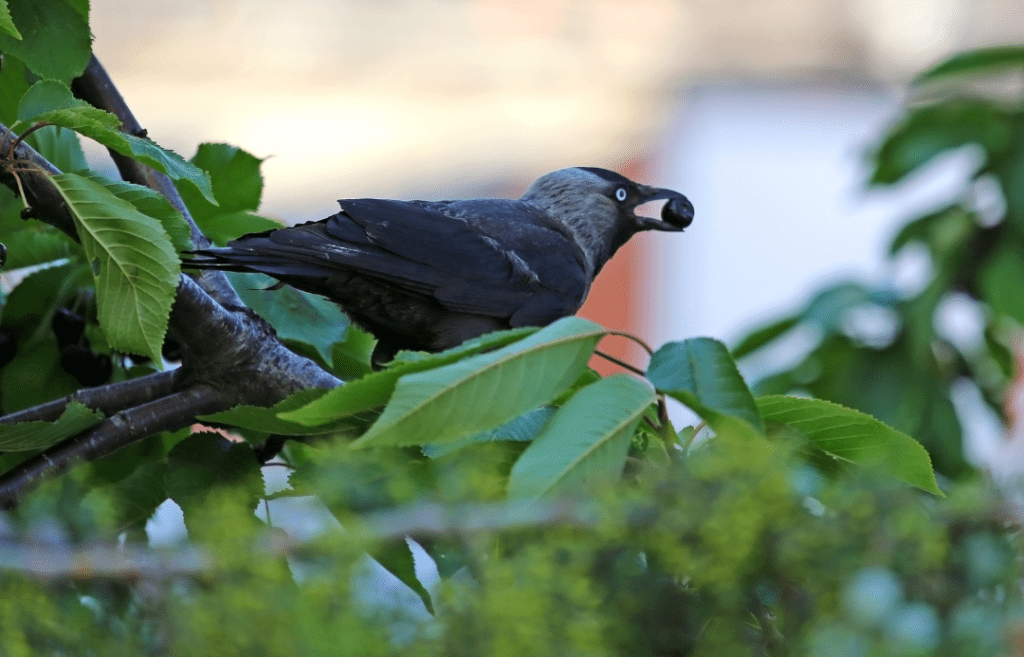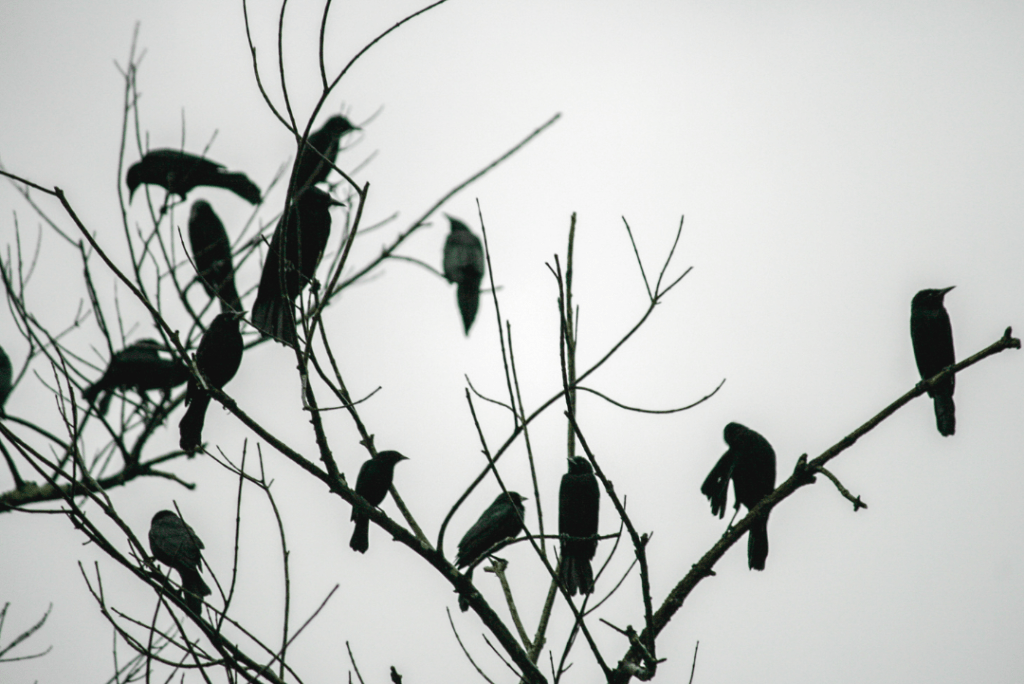If you want more crows in your yard, you can provide ideal habitat for roosting and nesting along with some of their favorite foods. Crows can live in all sorts of habitats and they aren’t picky eaters, but some of their favorite things include tall evergreen trees, consistent water sources, and, surprisingly, dog food.
In this guide, we’ll discuss crow visitation—why you may or may not want them around and how to attract them or drive them off. Here’s what we’ll cover:

- Why you might—or might not—want crows in your yard
- What do crows like to eat?
- How to provide food and water for crows
- Plants and trees that attract crows
- How to deter crows
Why You Might Want Crows In Your Yard

Not everyone prefers a crow’s jet black plumage and ominous caws over the cheerful chirps of sparrows or the vibrant colors of blue jays and cardinals.
However, there are plenty of crow enthusiasts who enjoy observing these fascinating creatures. Crows are incredibly smart, curious, and full of personality. They’re also comfortable around humans, making it easy to get up-close looks at their interesting behaviors.
Throughout history and to this day, crows have often been regarded as bad omens or treated with suspicion and hostility. There’s certainly a spooky element to the way they look, the noises they make, and their behavior.
However, if crows capture your interest and affection, you’re not alone. In recent decades, crows have been the subjects of increased scientific observation and research, as appreciation for their incredible intelligence has grown.
Few animals can do the things crows can do. They’ve proven capable of using simple tools, remembering human faces, and mimicking human speech.
Although negative superstitions are more common, various cultures around the world have held crows in high regard. The Nenet people of Arctic Russia believed that crows were sacred and could see into the future, while Vikings considered crows and ravens to be helper spirits of the god Odin.
Crows As Homestead Helpers
Curiosity and superstition aside, some folks want crows around for more practical reasons.
Gardeners appreciate that crows can devour grubs and other pests by the thousand.
Some chicken coop owners report that crows protect a flock by driving away predators like hawks and foxes. Crows are incredibly bold around larger animals, making them unlikely (and unintentional) guardians of more vulnerable companions.
Why You Might NOT Want Crows in Your Yard
Crows that frequent a spot in large numbers are often considered a nuisance.
If you have a bird feeder, crows may reduce the diversity of your visitors. Crows are known as “bird feeder bullies” that drive away small songbirds.

Here are a few more issues you might encounter if your property becomes the local hangout for crows. Crows may:
- Cause excessive noise
- Spread garbage around
- Eat garden crops
- Cause property damage by scratching surfaces or picking things apart
- Bully smaller birds away from the property
- Prey on smaller birds and eat their eggs
- Leave excessive droppings
- Display territorial aggression towards humans
Smaller songbirds may engage in any of the behaviors listed above. However, compared to most songbirds, crows are bigger, smarter, bolder, and congregate in larger groups. As a result, they’re capable of causing more significant nuisances.
What Do Crows Like to Eat?

Crows are super intelligent opportunistic omnivores, able to evaluate and pursue a wide variety of food sources.
Crows feed solo, in pairs, or in groups. Sometimes they work together, such as by chasing other animals from a food source. Crows will even pull on the tails of larger animals to distract them away from a meal.
Crow diets vary depending on habitat, but may include:
- Insects and worms
- Seeds
- Fruit
- Roadkill and other carrion (dead and decaying animals)
- Baby birds and eggs
- Small animals such as rodents, lizards, or fish
- Food waste from garbage
Crows are not birds of prey and they aren’t built for killing or tearing apart large animals. Live prey typically consists of insects and worms. However, larger animals like injured or baby birds, squirrels, or rats may be targeted by hungry crows.
Providing Food and Water for Crows
According to the Diva Crows Wildlife Rehab Center staff in Alexandria, Virginia, the reputation that “crows will eat anything” is true for the species, but not necessarily for individual crows. Here’s an excerpt from their blog:
“All of the bird books say that crows are omnivores. I suppose that’s true if by omnivore they mean “eats like a human four-year-old.” Crows taken together as a species probably eat just about anything, but any individual bird is going to have firm preferences.”
Outside of rehab settings, wild crows don’t need much help finding food.
However, providing a bird bath is one of the best things you can do to attract birds. Fresh water is often harder to come by than food. If you want to buy a bird bath that will attract crows, bigger is better. Crows are much larger than the birds that small baths are designed for.
If you do want to leave food out specifically for crows, here are your best bets:
- Raw, plain, unsalted nuts (peanuts, walnuts, almonds, or others)
- Dry kibble dog food or cat food (pea-sized pieces)
Never provide salted, sweetened, or artificially flavored foods. This article isn’t a comprehensive feeding guide—always do your research before adding a new food item to your bird feeding area.
Since crows are so intelligent and have a reputation for befriending humans, you might be tempted to entice a crow to eat out of your hand. This is not advisable.
First of all, touching a wild crow is far from sanitary, and potentially a disease risk. Secondly, hand feeding builds dangerous habits.
A wild animal that feels safe touching humans is likely to get itself into trouble. If you’re interested in forming a “special bond” with your backyard crows, you don’t need to feed them by hand in order for them to recognize you and perhaps even take a liking to you.
Do Crows Visit Bird Feeders?
Crows aren’t attracted to bird feeders to the same extent that smaller songbirds such as sparrows are. However, crows do visit feeders.
Some bird feeders are more easily-used by large birds like crows. These provide strong perches and enough space for large bodies. Open trays are another option.
Other feeders are designed specifically for small birds. These use features like weighted perches and protective cages that only small birds can fit through.
If you do or don’t want crows and other large birds at your feeder, plan accordingly. Just keep in mind that open-access feeding areas tend to be dominated by larger birds.

Plants and Trees That Attract Crows
You can attract birds to your property by providing plenty of plants and trees.
Before we discuss crows specifically, let’s consider some basic eco-friendly landscaping guidelines. To attract wildlife to your property, include as many of these elements as possible:
- A variety of mature trees
- Vegetation of different heights, including trees, shrubs, and flowers
- Native plants and pollinator-friendly plants
- A water feature, such as a bird bath or a pond
- No cats allowed
A property full of different plants and trees is also full of seeds and insects for birds to feed on, along with branches for nesting and roosting (sleeping).
Crows gather in large roosting groups each night, with hundreds or even thousands of individuals. So, while crows might like to visit your property for daytime snacks, they’re less likely to spend the night unless there are plenty of mature trees.
During nesting season (spring and early summer), crows form smaller family groups consisting of one or several mating pairs. Nesting crows are more likely to be dispersed throughout suburban and urban areas since groups are smaller and require less space.
For nests, crows prefer tall evergreen trees, such as firs. Nests are large, so trees with lots of branches and foliage are more suitable. Crows typically build their nest on a crotch near the trunk and close to the top of a tree.
Too Many Crows? How to Get Rid of Crows
It’s tough to outsmart a crow, but there are plenty of options for safely convincing crows that they would rather spend their time elsewhere.
First, if crows are a problem at your bird feeder, switch to one that’s designed specifically for small birds.

If crows are eating up your garden veggies, you can use nylon or steel bird netting to protect the plants. Some gardeners also try simple visual deterrents such as shiny strips of flash tape.
Decoys of humans (scarecrows) or large animals are useful short-term deterrents. Crows are scared off by dead crows, so another option is to hang a Halloween decor crow upside down, wings spread. It’s not the most cheerful garden display, but it’s effective.
Crows are too smart to be fooled by the same trick for long, so you should only expect short-term results from decoys like scarecrows or fake dead crows. To extend their usefulness, move them around every few days.
Learn More About Crows
Are you having a hard time telling crows apart from other black-colored birds? If you want to learn more about crows, a great place to start is our raven vs crow vs blackbird identification guide.

Kelly is an environmental science writer, naturalist, and birdwatcher. Kelly holds a master’s degree in environmental policy and has worked as an environmental analyst, urban planner, and professor of environmental planning.
